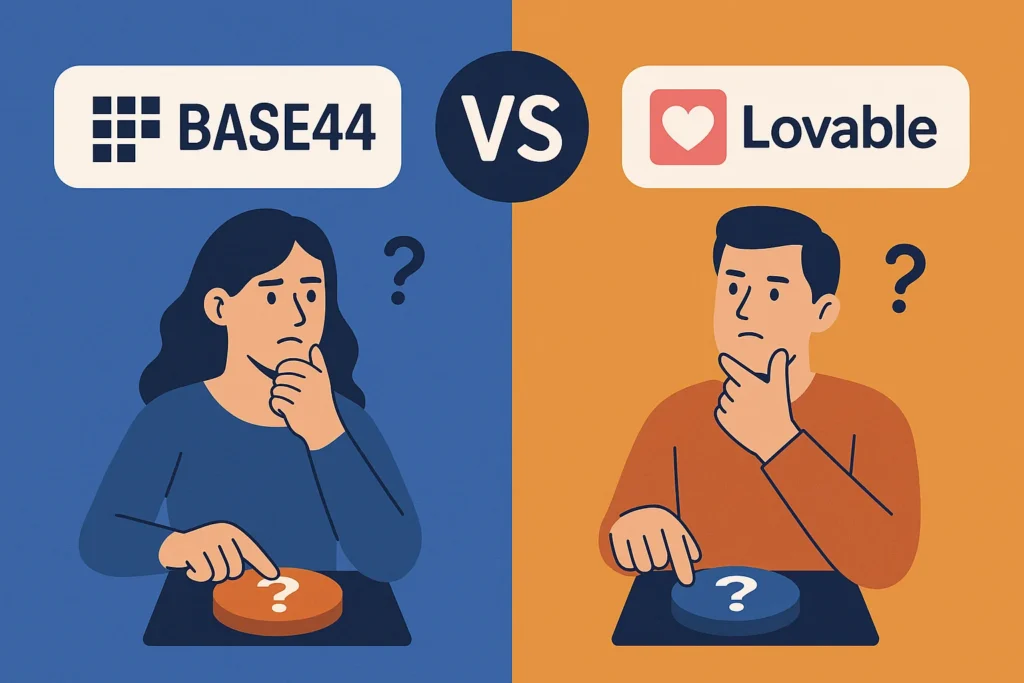Choosing between Base44 and Lovable comes down to your technical comfort level and project scope. Base44 is an all-in-one, AI-powered no-code platform that generates web applications from natural language prompts, handling backend services such as databases, authentication, file storage, and API generation. Lovable takes a modular approach, requiring you to connect external services like Supabase for backend functionality.
The platforms serve different audiences. Base44 streamlines rapid prototyping for external-facing MVPs. Lovable offers flexibility for developers who want control over their architecture.
Both platforms use AI chat interfaces to build applications. Both generate production-ready frontend code. The difference lies in how they handle backend integration and what that means for your workflow.
This comparison examines core features, pricing models, and use cases. You’ll understand which platform matches your technical requirements and project timeline. We’ll cover backend integration differences, AI functionality, and decision frameworks to help you choose.
What is Base44?
Base44 is an AI app builder designed for speed. You describe your application in plain language, and the platform generates a working web app.
The platform handles everything internally. Backend services such as databases, authentication, file storage, and API generation come built-in. You don’t connect external tools or manage separate services.
Base44’s apps are not ready for production, as they often lack the performance, scalability, and clean code needed for long-term use. The platform excels at creating functional prototypes quickly. Think investor demos, client presentations, or concept validation.
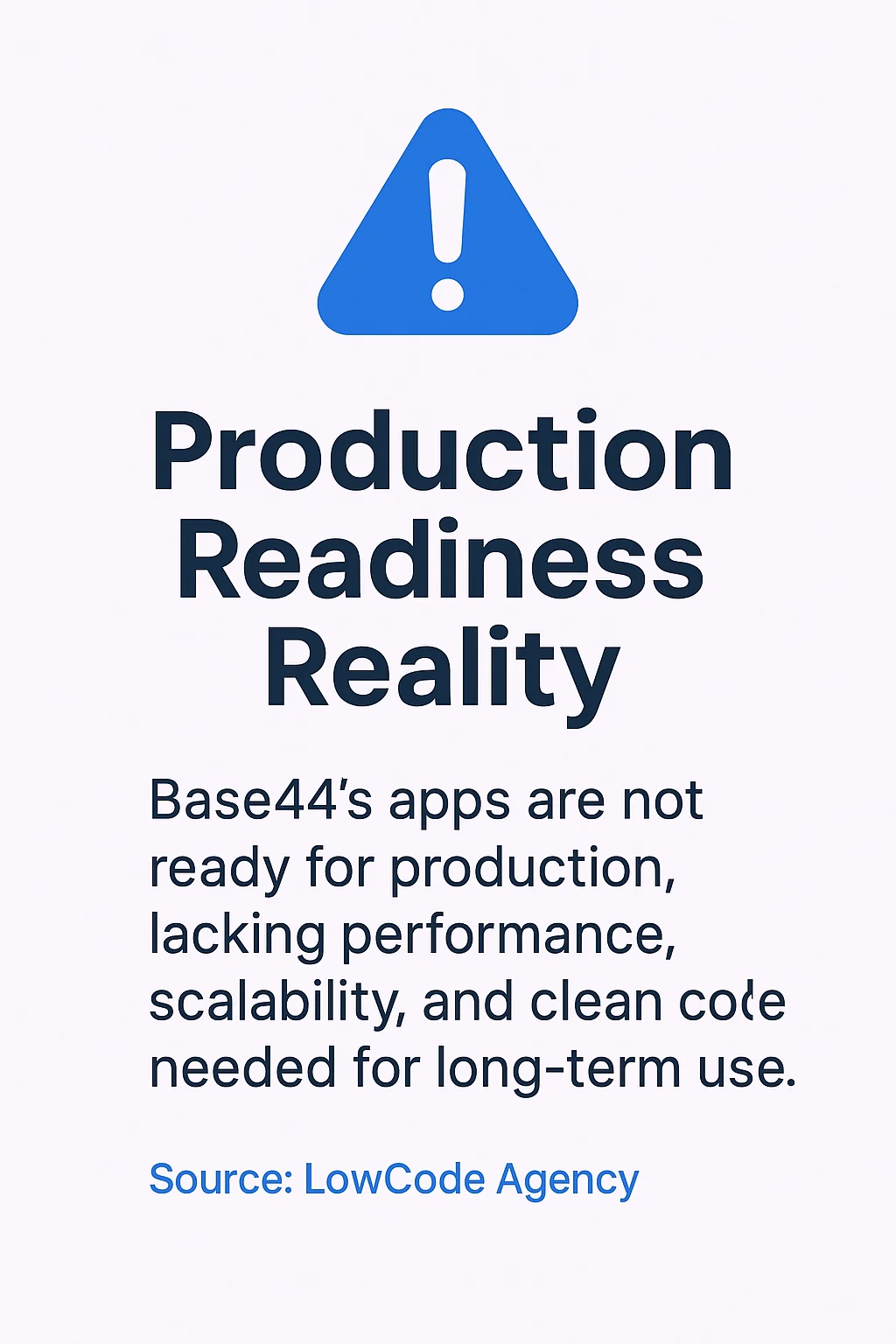
Wix acquired Base44 in mid-2025 to enhance its AI-driven development capabilities. This acquisition signals the platform’s growing relevance in the no-code space.
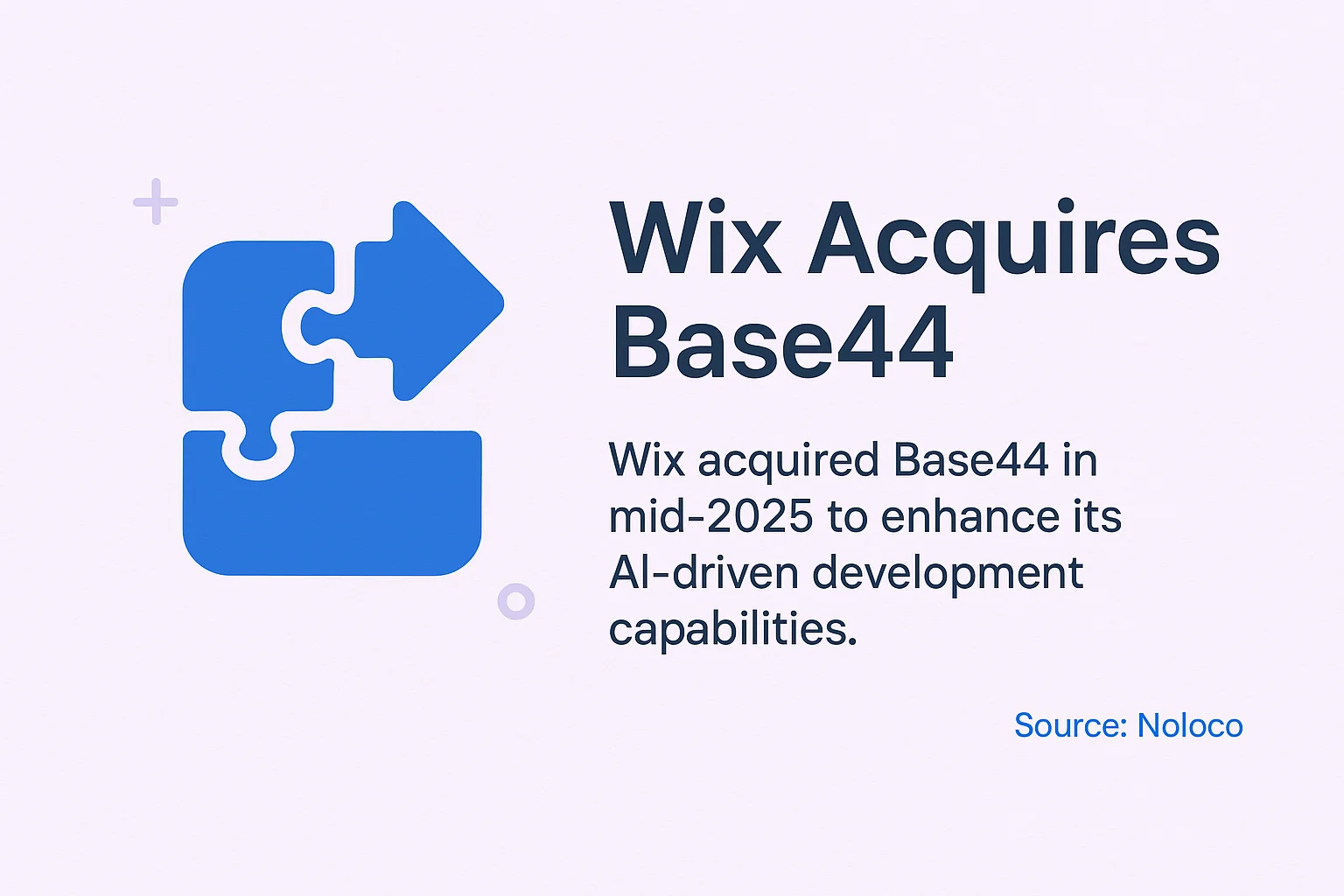
Core Features and Capabilities
The Builder Chat interface drives the entire experience. You type requests, and Base44 generates code. The platform uses Claude Sonnet 4 and Gemini 2.5 Pro for AI optimization.
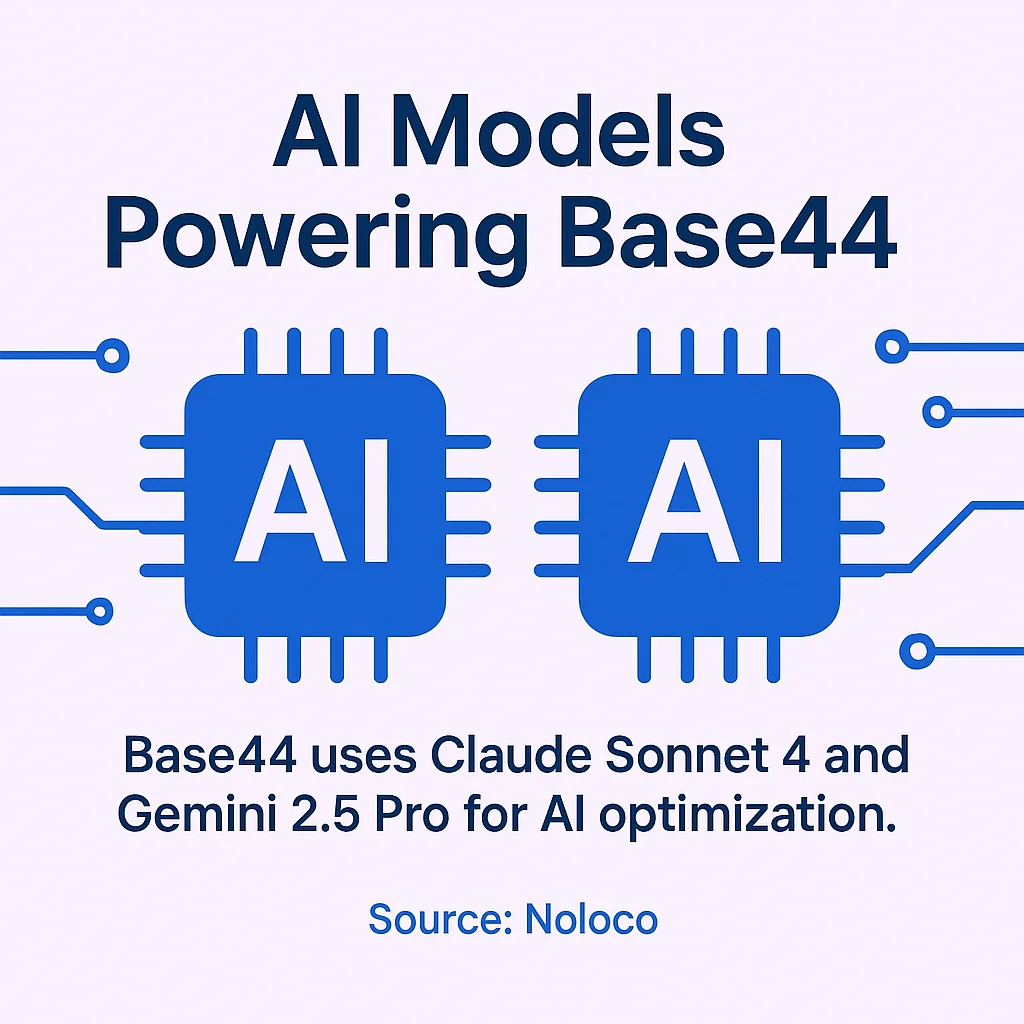
Backend features come integrated. You get database management without configuration. Authentication systems work out of the box. File storage connects automatically.
Base44 includes built-in analytics and supports custom domains. These features help you present prototypes professionally. Your demos can run on branded URLs with real-time performance tracking.
The conversational AI engine adapts to non-technical users. You don’t need coding knowledge to generate functional applications. The chat interface handles technical complexity behind the scenes.
Ideal Use Cases for Base44
Base44 is best for rapid prototyping and MVP development. The platform shines when speed matters more than architectural perfection.

External-facing MVPs represent the sweet spot. Customer portals, landing page applications, and client-facing tools work well. Base44 ‘may not be the right fit’ for internal tools like CRMs or project trackers, as these tools focus on external-facing MVPs.
Startup founders use Base44 for investor presentations. The platform creates working demos fast enough to test market interest. You validate ideas before committing to full development cycles.
Marketing teams build campaign-specific applications. Product managers create clickable prototypes for user testing. Consultants develop client presentation tools without technical overhead.
What is Lovable?
Lovable is an AI-powered app builder focused on flexibility. The platform generates frontend code while you control backend architecture.
You build applications through a chat-based interface similar to Base44. The difference appears in backend integration. Lovable connects to external services rather than providing built-in solutions.
Supabase integration represents the primary backend option. You manage databases, authentication, and storage through external platforms. This approach gives you architectural control and scalability options.
The platform targets developers who want AI assistance without sacrificing technical flexibility. You get rapid frontend generation while maintaining infrastructure choices.
Core Features and Capabilities
Lovable’s AI chat interface generates React and TypeScript code. The platform creates production-quality frontend components. You see live previews as the AI builds your application.
Backend integration requires external setup. You connect Supabase for database functionality. Authentication flows through your chosen provider. File storage connects to your preferred service.
GitHub integration enables version control from day one. Your code lives in repositories you control. You can modify generated code directly or continue using the AI chat interface.
The platform supports custom API integrations. You connect third-party services based on project requirements. This modularity lets you build complex workflows across multiple platforms.
Ideal Use Cases for Lovable
Lovable fits developers who want AI assistance with architectural control. The platform works for teams familiar with backend services and deployment processes.
Projects requiring scalability benefit from the modular approach. You choose backend infrastructure that grows with your application. Database optimization and server configuration remain under your control.
Technical teams building production applications use Lovable for frontend acceleration. The AI generates React components while developers manage infrastructure. This division of labor speeds development without sacrificing code quality.
Agencies building client applications prefer the flexibility. You integrate client-specific services and maintain consistent architecture across projects. The platform accelerates frontend work while you control technical specifications.
Key Features Comparison: Base44 vs Lovable
Both platforms use AI chat interfaces to generate applications. Both create functional web apps from natural language descriptions. The similarity ends there.
Base44 provides an all-in-one environment. Backend services come integrated. You start building immediately without external configuration.
Lovable requires backend setup before full functionality. You connect services manually. This approach demands more initial work but offers long-term flexibility.
| Feature | Base44 | Lovable |
|---|---|---|
| Backend Integration | Built-in (database, auth, storage) | External (Supabase, custom APIs) |
| Setup Complexity | Minimal (ready to use) | Moderate (requires service connections) |
| AI Chat Interface | Yes (Claude Sonnet 4, Gemini 2.5 Pro) | Yes (LLM-powered) |
| Code Export | Limited | Full (GitHub integration) |
| Customization | Chat-based modifications | Direct code editing + chat |
| Production Readiness | Prototype-focused | Production-capable |
| Version Control | Not emphasized | GitHub integration |
| Target User | Non-technical builders | Developers with backend knowledge |
AI Chat Functionality Differences
Base44’s chat interface handles complete application generation. You describe features, and the platform builds frontend and backend simultaneously. The AI manages database schemas, API endpoints, and authentication flows without explicit instructions.
Lovable’s AI focuses on frontend generation. You describe UI components and user flows. The platform generates React code with TypeScript. Backend functionality requires separate integration steps.
Both platforms use advanced LLM technology. Base44 leverages multiple models for optimization. Lovable focuses AI capabilities on frontend code quality and component architecture.
The chat experiences differ in scope. Base44 answers comprehensive application questions. Lovable specializes in frontend implementation details. Your backend questions require external service documentation with Lovable.
User Interface and Development Experience
Base44 prioritizes simplicity. The interface assumes no technical knowledge. You describe what you want, and the platform handles implementation details.
Lovable assumes development familiarity. The interface provides code access and GitHub integration. You switch between chat-based generation and direct code editing.
Live previews work similarly on both platforms. You see changes as the AI generates code. This immediate feedback loop accelerates iterative development.
Base44 limits manual code intervention. You rely on chat commands for modifications. Lovable encourages hybrid workflows combining AI generation with manual coding.
Database and Backend Integration
Backend architecture represents the fundamental difference between these platforms. This choice affects your entire development workflow.
Base44 includes database management in the platform. Tables generate automatically based on your application description. Relationships connect through the AI chat interface. You don’t write database queries or manage schemas manually.
Lovable requires external database setup through Supabase or similar services. You create tables, define relationships, and configure permissions separately. The platform generates frontend code that connects to your database.
Authentication and User Management
Base44 provides built-in authentication systems. User registration and login flows work without configuration. The platform manages session handling and security protocols internally.
Lovable integrates with external authentication providers. You configure Supabase auth or connect services like Auth0. This approach offers more authentication options but requires setup time.
Security implementation differs significantly. Base44 handles security through platform defaults. Lovable puts security configuration in your hands. You control authentication flows and permission systems.
User management interfaces come standard in Base44. The platform generates admin panels for user oversight. Lovable requires you to build or integrate user management tools.
File Storage and Asset Management
Base44 includes file storage as a built-in feature. Users upload files through generated interfaces. The platform manages storage allocation and file retrieval automatically.
Lovable connects to external storage services. You integrate Supabase storage, AWS S3, or similar solutions. File handling requires configuration but offers unlimited scalability options.
Asset optimization works differently. Base44 handles image compression and file optimization internally. With Lovable, you configure optimization through your chosen storage provider.
The storage approach affects long-term costs. Base44 includes storage in subscription pricing. Lovable’s storage costs depend on your external service provider and usage patterns.
Pricing Models: Base44 vs Lovable
Base44 offers paid plans starting at $29 per month. This subscription includes backend services, hosting, and AI generation capabilities. The pricing covers your complete development environment.
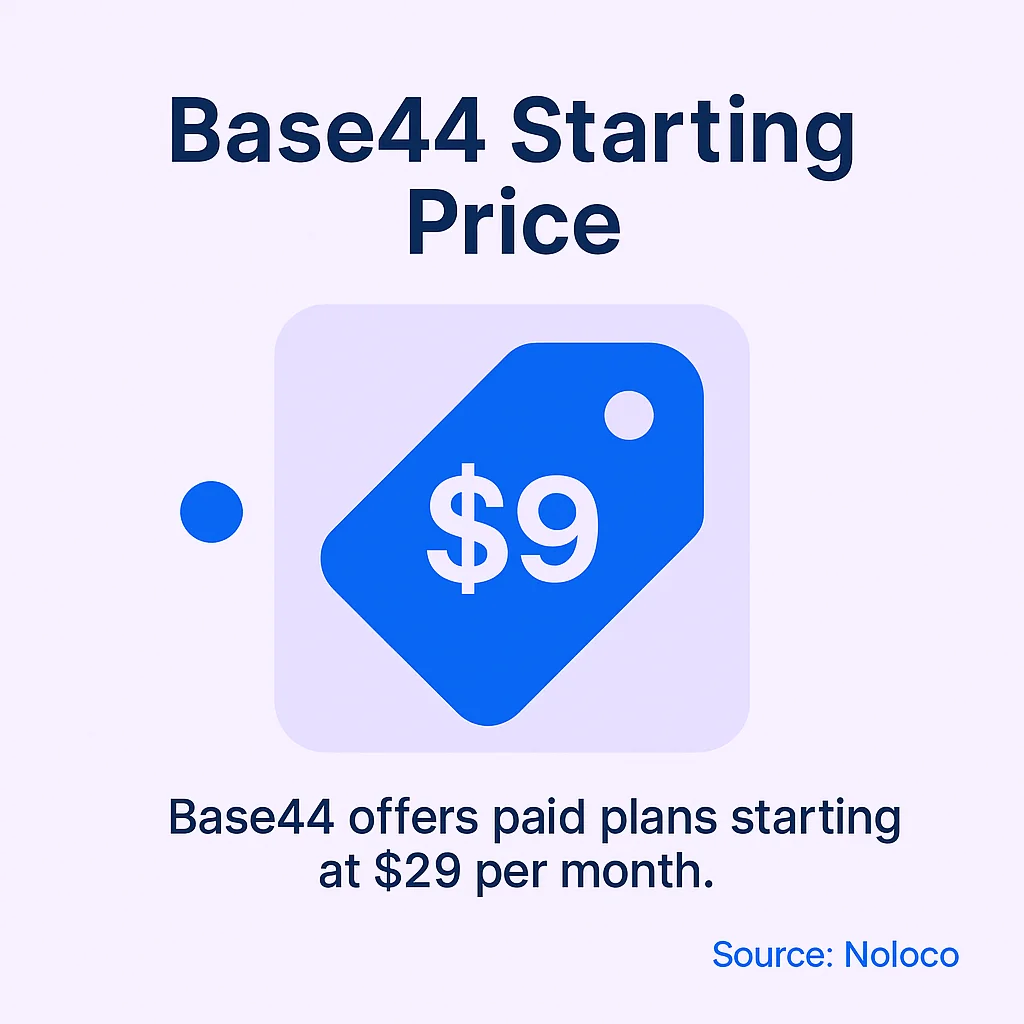
Lovable uses a credit-based pricing system. You purchase message credits for AI interactions and integration credits for external services. This model charges based on actual usage rather than flat monthly rates.
| Pricing Element | Base44 | Lovable |
|---|---|---|
| Starting Price | $29/month | Credit-based (varies by usage) |
| Backend Services | Included | Separate (Supabase costs) |
| Hosting | Included | Separate deployment costs |
| AI Interactions | Unlimited in plan | Per-message credits |
| Storage | Included | External service fees |
| Custom Domains | Included | Depends on hosting choice |
Value Considerations
Base44’s flat subscription simplifies budgeting. You know monthly costs upfront. The all-in-one approach includes services you’d pay for separately with Lovable.
Lovable’s credit system offers usage flexibility. Light users pay less than heavy users. Projects with variable development intensity benefit from this model.
External service costs add to Lovable’s total expense. Supabase charges separately for database usage and storage. Hosting costs depend on your deployment platform choice.
Base44 includes hosting and deployment. Your applications run on Base44 infrastructure. This convenience comes at the cost of less control over server configuration.
Scalability and Long-Term Costs
Base44’s pricing remains consistent as applications grow. The platform handles infrastructure scaling internally. You pay subscription fees regardless of traffic or database size within plan limits.
Lovable’s costs scale with your application. Database growth increases Supabase fees. Higher traffic raises hosting costs. This model charges for actual resource consumption.
Production applications face different cost trajectories. Base44’s fixed pricing works for predictable usage. Lovable’s variable costs suit applications with fluctuating demand.
Budget predictability differs between platforms. Base44 offers consistency. Lovable requires ongoing cost monitoring based on application performance and growth.
The Main Difference: All-in-One vs Modular Approach
The fundamental choice comes down to integration philosophy. Base44 bundles everything together. Lovable keeps services separate.
Base44’s all-in-one approach prioritizes speed. You start building immediately. No service connections, no configuration files, no deployment setup. The platform handles technical infrastructure while you focus on application features.
Lovable’s modular approach prioritizes control. You choose backend services that match your requirements. Database technology, authentication providers, and hosting platforms remain flexible. This freedom requires technical knowledge and setup time.
Development Speed Comparison
Base44 reaches working prototypes faster. The integrated environment eliminates setup delays. You describe your application and see results within minutes.
Lovable requires initial configuration time. You set up Supabase, configure authentication, and establish deployment pipelines. This upfront investment pays off in architectural flexibility.
Iteration speed varies by use case. Base44 handles simple changes through chat commands. Complex modifications require AI interpretation. Lovable lets you edit code directly for precise changes.
Team collaboration differs between platforms. Base44 works through a single interface. Lovable integrates with standard development workflows using GitHub and version control systems.
Technical Flexibility and Customization
Base44 limits customization to chat-based modifications. You can’t access underlying code architecture. The platform’s opinions about structure and implementation remain fixed.
Lovable provides full code access. You modify generated React components directly. Backend integration follows your architectural preferences. This flexibility matters for complex applications with specific requirements.
API integration capabilities differ significantly. Base44 handles integrations through its built-in systems. Lovable connects to any API using standard HTTP requests and webhooks.
Migration paths vary dramatically. Base44 applications live within the platform ecosystem. Moving to traditional hosting requires rebuilding. Lovable applications use standard technologies, making migration straightforward.
Decision Framework: Choosing Your Platform
Your choice depends on three factors: technical experience, project scope, and timeline requirements. These elements determine which platform serves your needs better.
Choose Base44 if you need rapid prototyping without technical overhead. The platform works for founders validating ideas, marketers building campaign tools, or consultants creating client demos. Speed matters more than architectural perfection.
Choose Lovable if you need production-ready applications with architectural control. The platform suits developers building scalable products, technical teams accelerating frontend work, or agencies managing multiple client projects with varying infrastructure needs.
Technical Experience Requirements
Base44 requires minimal technical knowledge. Non-technical founders build functional prototypes. The conversational interface handles complexity through natural language processing.
Lovable assumes development familiarity. You understand backend services, database management, and deployment processes. The platform accelerates work for people already comfortable with web development concepts.
Learning curves differ substantially. Base44 users learn through experimentation and chat interactions. Lovable users need existing knowledge of React, TypeScript, and backend integration patterns.
Support requirements vary accordingly. Base44 users need platform-specific guidance. Lovable users benefit from general web development knowledge and external service documentation.
Project Scope Considerations
Short-term projects favor Base44’s integrated approach. Quick demos, validation tools, and temporary applications don’t justify extensive setup. The platform delivers results within tight deadlines.
Long-term applications benefit from Lovable’s flexibility. Production systems require scalability planning and architectural choices. The modular approach prevents platform lock-in as requirements evolve.
Team size influences the decision. Solo builders appreciate Base44’s simplicity. Development teams leverage Lovable’s version control and collaborative coding capabilities.
Budget considerations extend beyond subscription costs. Base44’s predictable pricing suits fixed budgets. Lovable’s variable costs align with usage-based budget models and growing applications.
Making Your Decision
Base44 and Lovable solve different problems with AI-powered app building. Your choice reflects your technical comfort and project requirements.
Base44 excels at rapid prototyping for external-facing MVPs. The all-in-one platform eliminates setup time and technical barriers. You sacrifice architectural control for speed and simplicity. This trade-off makes sense for idea validation, investor demos, and quick client presentations.
Lovable provides frontend acceleration with backend flexibility. The modular approach demands technical knowledge but delivers production-ready applications. You control infrastructure choices while AI accelerates interface development. This balance suits scalable products and complex integrations.
Start with your timeline and technical expertise. Need a working prototype this week without coding knowledge? Base44 fits perfectly. Building a production application with growth plans and development experience? Lovable offers the flexibility you need.
Both platforms represent the evolution of AI-assisted development. The right choice depends on whether you value integrated simplicity or modular control. Your project goals, not the platform’s capabilities, should drive this decision.

